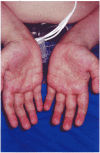Graft-versus-host disease
- PMID: 19282026
- PMCID: PMC2735047
- DOI: 10.1016/S0140-6736(09)60237-3
Graft-versus-host disease
Abstract
Haemopoietic-cell transplantation (HCT) is an intensive therapy used to treat high-risk haematological malignant disorders and other life-threatening haematological and genetic diseases. The main complication of HCT is graft-versus-host disease (GVHD), an immunological disorder that affects many organ systems, including the gastrointestinal tract, liver, skin, and lungs. The number of patients with this complication continues to grow, and many return home from transplant centres after HCT requiring continued treatment with immunosuppressive drugs that increases their risks for serious infections and other complications. In this Seminar, we review our understanding of the risk factors and causes of GHVD, the cellular and cytokine networks implicated in its pathophysiology, and current strategies to prevent and treat the disease. We also summarise supportive-care measures that are essential for management of this medically fragile population.
Figures



References
-
- Appelbaum FR. Haematopoietic cell transplantation as immunotherapy. Nature. 2001;411:385–389. - PubMed
-
- Welniak LA, Blazar BR, Murphy WJ. Immunobiology of allogeneic hematopoietic stem cell transplantation. Annu Rev Immunol. 2007;25:139–170. - PubMed
-
- Billingham RE. The biology of graft-versus-host reactions. Harvey Lect. 1966-67;62:21–78. - PubMed
-
- Korngold R, Sprent J. Purified T cell subsets and lethal graft-versus-host disease in mice. In: Gale RP, Champlin R, editors. Progress in Bone Marrow Transplantation. Alan R. Liss, Inc.; New York: 1987. pp. 213–218.
-
- Kernan NA, Collins NH, Juliano LL, Cartagena TT, Dupont BB, OReilly RJ. Clonable T lymphocytes in T cell-depleted bone marrow transplants correlate with development of graft-v-host disease. Blood. 1986;68:770–773. - PubMed
Publication types
MeSH terms
Substances
Grants and funding
LinkOut - more resources
Full Text Sources
Other Literature Sources
Medical

